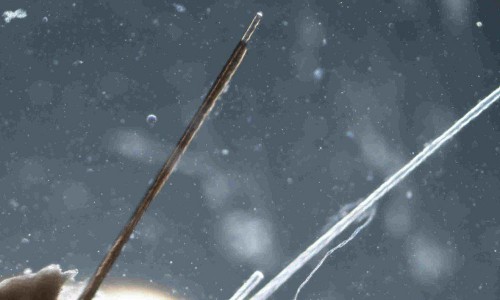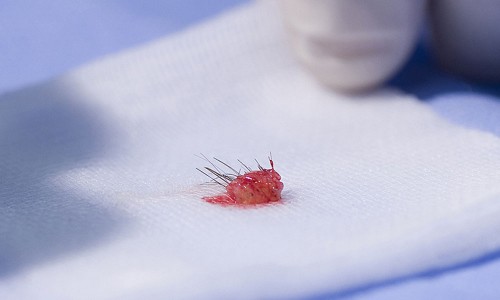Introduction to Polona Tratnik, by Anja Wiesinger
Hair is a special material. In a biological sense, being part of the human skin, it regulates the body temperature. It is home to millions of bacteria that interchange with the environment and help build the body’s resistance to harmful organisms. Hair is not able to grow or continue to live when departed from the human body and cut off from the bloodstream. However, if the organism stays intact, hair will extend and renew in what is generally understood as reproduction. This is a promising prospect for stem cell research, tissue engineering and immunology – fields that are all working on ways to heal or prolong the life of the human body.
Being a signifier for health, fruition, and beauty, hair also fulfills an aesthetic function. It is a medium with tactile qualities, associated with intimacy on the one hand, and with the abject on the other hand. Charged with a sexual appeal, playing with one’s own hair is a common gesture in a flirt situation. Hairstyles express personal tastes and values. In fashion, hair is set in place and staged against the laws of nature. The desire for more hair may bring aesthetic surgery to the scene. These surgeries can already successfully transplant and grow hair.
The use of hair in the work of Polona Tratnik, however, demonstrates that hair growth is a far more complex issue. Tratnik holds a Ph.D. in philosophy and visual culture and works as an assistant professor at the University of Primorska. In the past ten years she has accomplished many important projects reflecting on the impact of biology and Artificial Life research – in particular biotechnology – on the micro level of the human body. Tratnik’s artistic body of work of the past ten years such as 37° (2001-2003), Hair (2005) and In Vitro and Transspecies (2008) has led to her most recent project Hair in Vitro (2010) as an ongoing project in collaboration with medical institutions in Slovenia.
Hair in Vitro exports a laboratory situation into an art space. A piece of hair together with its connected skin is taken from a human donor and placed in vitro and held at the body temperature of 37° Celsius. The hair in the glass continues to grow, as part of a body separated from its body. The result is a living technological machinery-organism: the re-rendered process of enhancing the human living organism with artificial elements, parts of the human living organism transferred into an artificial environment. The project places philosophical questions of self and other into scientific and epistemological contexts. In this situation, the artificial and the natural are no longer easily dissociated from one another.
Art for Tratnik provides a space for the humanities and philosophy to meet with science. She invites a wider audience to participate in sensual experiences associated with a topic that is usually withdrawn from everyday life. There is a sensual encounter with something usually hidden from the gaze. In the enclosed technical environment of Hair in Vitro, the visible is encouraged but also called into question, since hair does have tactile qualities and is withdrawn through the glass. Visibility fails to take account of life processes. It needs to be mediated by other technologies in a Benjaminian sense of revealing a different nature, other than that nature that human perception is able to grasp.
Hair cultivation becomes metonymical with the design of living material. There is no media in terms of transport or carrier which produces meaning or holds a piece together. It is best described – in the words of Tratnik – as “performing a situation.” By attributing properties of performativity to living material, the emphasis shifts towards doing and action, contrary to the notion of material objects which are passive and motionless. The time-lapsing capability of the video media adds multiple layers of time to reveal the slow growth processes on the micro time level.
Placing a living object in a machinic and sterile environment under conditions that extend its life, inciting the desire to grow and blossom, appears to be a queer moment, a crossover that questions common assumptions. This act invites and inverses thinking about strategies of healing and prolongation. Is life an endless source? Is life something that lives by subtracting energy from its environment? Is life something that spreads out infinitely? Is nature a circle striving for balance between mortification and vitalization?
Harmful bacteria, for example, are usually seen as something dreadful and threatening, something to be killed by antibiotics, by medicine. But what if the aim were to use these bacteria – or ill-designed processes such as the development of cancer – to make the body stronger, to integrate, to enforce any form of life? Do we want to stay human the way that we understand ourselves as human?
These questions can challenge the concept of Artificial Life, according to Tratnik understood as a multiplication and transplantation of body code or body cells. Her work raises questions about the border of the human body, the autonomy of the body and its body parts, and the difference between human and non-human micro-organisms. Not to mention the implications of the instrumentalization of living material for use or potential abuse.
This transdisciplinary approach in Tratnik’s work exposes to view the limits of the organization of science into the disciplines (using and reflecting on biotechnology as such) as they are formed by language, methodologies, and classification systems in knowledge production. Disciplines form a social field in Bourdieu’s sense in which social interactions take place and power is exercised. In her series of investigations, Tratnik connects local scientific practices with a more general discourse on science. For example, microsurgery was invented in Slovenia. Her projects place an emphasis on the embodied and subjective practices of scientists, and also on the scientific notion and treatment of the human body as an object of observation and experimention — therefore as something nonhuman. The work Hair in Vitro enables a broader dialogue about ethics, one which includes both the human and the nonhuman, questioning the appropriateness of these categories and their borders. The biotechnical term tissue becomes a metaphor for being a part of the giant “tissue of the world.”

